
Guest contributor: David Abrams
Late Encounters with Flannery O’Connor
categories: Cocktail Hour / Reading Under the Influence
3 comments
The zenith of my literary fanboy life surely came in those minutes I sat on Flannery O’Connor’s toilet.
Blame it on the Chinese food. For weeks, I’d looked forward to this moment: the day I would first set foot inside Flannery’s childhood home. I’d Googled, I’d Mapquested, I’d made dry runs on the route through southern Georgia, I’d Wise Blood-ed myself to death. But now something stood in the way of Complete Flannery Fulfillment: the Chinese food.
Two hours before our arrival in downtown Savannah, my wife and I stopped for a quick meal of meat, vegetables and MSG. The food was good and quickly settled into our stomachs. In my case, it also traveled farther south at an alarming pace.
By the time we parked the car a few blocks away from the Flannery O’Connor Childhood Home on Charlton Street, my skin was getting clammy and blood was starting to drain from my face, my fingertips were chill with tingle. I walked along the sidewalk like the man with the proverbial stick up his ass. Which, I suppose, was true in so many unspeakable ways.
My wife took one look at my grimacing face and said, “You’re kidding, right?”
I shook my head.
She sighed. “You couldn’t have taken care of this when we stopped for gas thirty minutes ago?”
“It wasn’t an issue at that point.”
“We can always turn around and come back another day.”
“No, not another day.”
I’m sure my wife was more than a little concerned by the hypno-spiral look in my eyes, the fevery sheen on my forehead, the high squeak of my voice when I talked about making this pilgrimage to the home of my idol.
When we reached the former residence of the O’Connor family, we climbed the steep stone staircase leading from the sidewalk to the front door. That door was a good fifteen feet above street level, as high and mighty as some cathedral entrances. Looking back, I think I deserve some sort of Olympic medal for the way I, uh, kept it all in during the ascension.
The building is a nondescript mole-colored three-story home squeezed into place on the block, looking like it was a young child pushing through adult legs to see a passing parade. The only thing remarkable about it was the human contents which once lived inside its walls during the Great Depression.
Despite the distractions of my body, I felt like Dorothy and her friends must have felt when they topped that rise in the poppy field and saw the emerald shards of the City of Oz jutting before them. I was here, I was really here. I was about to walk where Flannery once walked. A very young Flannery, to be sure, but Flannery all the same. What would I say? What would I do when I stepped inside and was enveloped in the environment where once she had played as a child? How would I greet the particles of her ghost that still floated like motes through the air of the house?
I opened the door, stepped across the threshold, and grinned sheepishly at the bald tour guide who was bustling down the hallway to greet us. “Can I use your bathroom, sir?”
* * *
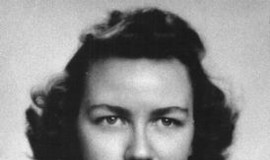 The object of my literary affection was born Mary Flannery O’Connor at St. Joseph’s Hospital in Savannah on March 25, 1925. The one-word weather forecast in the local newspaper that blustery spring day, biographer Brad Gooch tells us, was: “unsettled.” The author herself couldn’t have picked a more apt word to herald the arrival of someone who, I contend, was the most unsettling novelist of the 20th century.
The object of my literary affection was born Mary Flannery O’Connor at St. Joseph’s Hospital in Savannah on March 25, 1925. The one-word weather forecast in the local newspaper that blustery spring day, biographer Brad Gooch tells us, was: “unsettled.” The author herself couldn’t have picked a more apt word to herald the arrival of someone who, I contend, was the most unsettling novelist of the 20th century.
My devotion to F. O’C. began in my undergraduate years at the University of Oregon when I enrolled in a 20th-Century American Literature course. Syllabus in hand, I stalked the aisles of Smith Family Bookstore in search of this writer I’d never heard of: Frank O’Connor, I think it was? No, Flannery–Flannery O’Connor, that’s it. I ran my index finger along the O-Apostrophe shelf until it stopped on a chunky, white Signet paperback, an omnibus edition of Wise Blood, Everything That Rises Must Converge, and The Violent Bear It Away. There were no used copies on the shelf. Apparently, those who bought Flannery O’Connor kept her. I splurged the extra three dollars on the clean, unbroken, virgin-tight paperback copy. The cover design showed a twilight-dim country road curving into a blood-orange sun.
Twenty-five years later, I still have that paperback copy. Its margins are dark with ballpoint notes, the pages are swollen, and the spine is curved and creased. The setting sun is scuffed from all the times I’ve read, re-read, and re-re-read what lies within:
A blinding red-gold sun moved serenely from under a purple cloud. Below it the treeline was black against the crimson sky. It formed a brittle wall, standing as if it were the frail defense he had set up in his mind to protect him from what was coming. The boy fell back on his pillow and stared at the ceiling. His limbs that had been racked for so many weeks by fever and chill were numb now. The old life in him was exhausted. He awaited the coming of new. It was then that he felt the beginning of a chill, a chill so peculiar, so light, that it was like a warm ripple across a deeper sea of cold. His breath came short. The fierce bird which through the years of his childhood and the days of his illness had been poised over his head, waiting mysteriously, appeared all at once to be in motion. Asbury blanched and the last film of illusion was torn as if by a whirlwind from his eyes. He saw that for the rest of his days, frail, racked, but enduring, he would live in the face of a purifying terror. A feeble cry, a last impossible protest escaped him. But the Holy Ghost, emblazoned in ice instead of fire, continued, implacable, to descend.
–“The Enduring Chill”
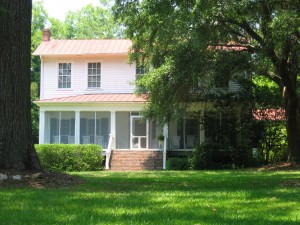 My Flannery fever reached its pitch when I was living on the edge of the tundra in Fairbanks, Alaska and attending graduate school there. You don’t need to be a geography whiz to know that Fairbanks, Alaska is about as far away from Flannery as you can get–both in thermometer and in temperament. I thought no one there would know who she was, I thought she would be my own little secret, a warm ball of fur I carried around in the pocket of my parka which I’d reach in and touch when I wanted to feel superior, literary-wise, to everyone else buying reindeer sausage at the supermarket.
My Flannery fever reached its pitch when I was living on the edge of the tundra in Fairbanks, Alaska and attending graduate school there. You don’t need to be a geography whiz to know that Fairbanks, Alaska is about as far away from Flannery as you can get–both in thermometer and in temperament. I thought no one there would know who she was, I thought she would be my own little secret, a warm ball of fur I carried around in the pocket of my parka which I’d reach in and touch when I wanted to feel superior, literary-wise, to everyone else buying reindeer sausage at the supermarket.
I was wrong–completely uncharitable in my thinking. There were many Flannery fans in Fairbanks (and, for all I knew, Anchorage, Nome, and Point Barrow). Chief among them was my professor and lifelong mentor, Frank Soos (himself the author of a very good collection of short stories).
Like every good MFA student, I wrote it all down in a journal:
March 18, 1993 (Fairbanks, Alaska): Some pertinent notes from my Forms of Fiction class tonight: Frank Soos, who has dedicated his life to the works of Alice Munro and Flannery O’Connor, said, “The reading public thought Flannery was being ironic towards religion. They weren’t sure how to take her stories — was she being SERIOUS about Christianity?”
Another student (beard, Carhartts, sandpaper voice): “Flannery is almost medieval in her outlook.”
Frank: “What does everyone else think?”
Sound effect: Cicadas, mixed with car tires on gravel road. Various points of view, mostly leaning toward the Protestant. Me, I kept silent. O’Connor was still my secret Shazam! ring. I didn’t let anyone else have the decoder.
Factiod #1: I just learned that some monks sleep in coffins to better prepare themselves for death.
Factoid #2: I also just learned that grayling hibernate. I’ll have to research this, but I was told that in the fall, their bodies slow shut down, heartbeats dwindle and when the river freezes over, they become encased in ice and remain that way until the spring.
Question: What would Flannery O’Connor make of all this?
Tonight, after coming out to my van in the parking lot on campus, I discovered someone had put a half-eaten cookie under my windshield wiper. I started thinking about the person who had studied my car, then in full view of everyone, raised my wiper and stuck the chocolate chip cookie against the glass like a parking ticket. Who would do such a thing?
The same kind of person who’d steal an artificial leg from a girl named Hulga/Joy, that’s who.
“We are obsessed with other writers’ processes and behaviors—with a writer’s space: The room, the desk, the tools are all a part of the equation. Seeing the place where a successful author created her work can be encouraging and grounding. The writer’s space is proof it can be done.”
–A. N. Devers, quoted in “Inside Writers’ Houses” by Alex Dimitrov, Poets & Writers Magazine, March/April 2011
After I asked my question, the bald tour guide at the Childhood Home pointed down the hall, past the kitchen to a back room where, he said, there was a bathroom. He said it reluctantly, fussily, like he really wanted to be holding up a sign that read “No Public Restrooms” but felt he had to surrender to what looked like panic and despair written large on my face.
I thanked him and waddle-limped down the hallway, leaving my wife, the one person in the world most disinterested in Flannery O’Connor, to strike up an uncomfortable conversation. I closed the door on the little closet-sized bathroom, dropped my pants, settled my ass cheeks on the toilet seat, and
[deleted]
As I sat there in the aftermath, all I could think was: “I am sitting* in Flannery O’Connor’s bathroom!” Had her hindquarters once sat where mine now did? My chest filled with the warmth of our new-blossomed kinship.
Even after I’d taken a closer look at my surroundings and noted the chrome handle on the toilet, the post-1980 architecture of the bowl and tank, and even taking into account the still-shiny bolts which held it to the floor, I couldn’t be talked out of my new, trans-century connection to my literary heroine.
I washed my hands (IN FLANNERY’S SINK!), dried them (ON FLANNERY’S TOWELS!), then made my way back through the house to find our tour group had doubled in size with the addition of a husband and wife–Floridians, by the looks of them. The lady wore a voluminous dress that leaned more on the side of comfort than fashion; her husband was clad in shorts, sandals, and knee-high socks. His face and arms were brutally tan, his legs were not. You needed sunglasses to look for any length of time at his legs.
As I approached, the look on my wife’s face said many things. It said, “Oh, thank God you’re back to rescue me from these insufferable morons!” It said, “We are never doing this again, so enjoy it while you can, buddy.” It said, “How bad of a stink did you leave back there?”
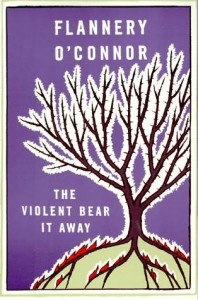 The docent was well into his docenty tour-guide narration by the time I re-joined the group. Without breaking stride, he gave me a look like I was now forever in his debt for being allowed the privilege to break the House Rules** and use the non-public restroom. I began to not like him very much at that moment. Plus, I thought he kind of looked like a computer programmer with nothing better to do on the weekend. He was dressed in a short-sleeved shirt tucked into navy-blue sweat pants that rose high over his shoes as if he was fully prepared for a flood. The pants were cinched tightly above his waist–the sort of thing an eighty-year-old man walking to the Sav-Mor in Sun City, Arizona might be seen wearing, not a fifty-year-old employed in the service of Flannery O’Connor’s legacy. His eyeglasses balanced on top of two puffy cheeks which summited in two hard knobs then spread and flared toward the back of his jaw coming finally to rest in meaty jowls which gave me a sudden craving for Jell-O. What little hair he retained was slicked back and over the dome of his head in sad, thin rivulets. I couldn’t help thinking he’d have been better off if someone had been there to shoot him every minute of his life.
The docent was well into his docenty tour-guide narration by the time I re-joined the group. Without breaking stride, he gave me a look like I was now forever in his debt for being allowed the privilege to break the House Rules** and use the non-public restroom. I began to not like him very much at that moment. Plus, I thought he kind of looked like a computer programmer with nothing better to do on the weekend. He was dressed in a short-sleeved shirt tucked into navy-blue sweat pants that rose high over his shoes as if he was fully prepared for a flood. The pants were cinched tightly above his waist–the sort of thing an eighty-year-old man walking to the Sav-Mor in Sun City, Arizona might be seen wearing, not a fifty-year-old employed in the service of Flannery O’Connor’s legacy. His eyeglasses balanced on top of two puffy cheeks which summited in two hard knobs then spread and flared toward the back of his jaw coming finally to rest in meaty jowls which gave me a sudden craving for Jell-O. What little hair he retained was slicked back and over the dome of his head in sad, thin rivulets. I couldn’t help thinking he’d have been better off if someone had been there to shoot him every minute of his life.
He nattered on and on about how Regina and Ed O’Connor moved into the Charlton Street town house in 1923; how the rooms of the house were flooded with the sound of tolling bells from the Cathedral of St. John the Baptist across the street every morning, noon, and evening; how Mary Flannery O’Connor was born just a few blocks south at St. Joseph’s Hospital on March 25, 1925; how she used to disrupt her elementary school classes by saving a mouthful of food she ate for lunch then later, hiding behind a book, get her friend’s attention by opening her mouth to show her “see food.”
I’d heard most of the stories before, so my attention started to wander to the rest of the house: the Edwardian-era furniture, the fireplace mantle, the mint-green walls, the baby carriage which had once held Flannery’s tiny pink body, as small and curled as a shrimp plucked from the tidal waters of the Ogeechee River.
Built in 1856 of Savannah gray bricks, covered in light tan stucco, the O’Connors’ three-story Georgian row house, its front door topped with a ruby etched-glass transom, was still joined, in 1925, with 209 East Charlton Street….Mrs. O’Connor took pride in the modest elegance of her well-kept parlor floor with its small entrance foyer; attractive, dark green double living room with two black marble fireplaces, two chandeliers, and four eight-foot bay windows; large dining room with a heavy dark oak table, where the family would gather for formal meals; small kitchen; and back sunporch, where she kept her green plants. Upstairs, the parents’ front bedroom was connected by a doorway to their daughter’s back bedroom, both heated in winter by coal fireplaces.
–from Flannery: A Life by Brad Gooch
“And now,” the docent said, “I’ll take you to the back of the house and we’ll see the yard where Flannery once taught a chicken to walk backwards.”
Mr. Highwater Pants shepherded us from the parlor toward the back of the house. As we passed the open door of the bathroom, his face curled. He held a forefinger just below his nostrils. “Oh,” he said.
I looked at my wife. She looked at me. I shrugged. She shook her head in disapproval and shame.
Our small group stood on the back porch, looking out at the yard, the size of an index card, where H.P. told us Flannery’s first brush with fame took place. “In 1931, five-year-old Mary Flannery taught a chicken to walk backwards.”
“Really?!” exclaimed the husband from Florida.
“My, my,” his wife said from within the tent of her dress.
“As a matter of fact,” the docent continued, “her fame for this fowl trick–” (Pause for group chuckle) “–eventually attracted the attention of the Pathe News Service and they dispatched one of their newsreel photographers from New York down here to Savannah to do a funny little film–the kind you’d see before they showed the double feature back in the 1930s. Flannery is only on-screen for a few seconds, but it was an experience she would remember for the rest of her life.”
* * *
By the time we climbed the stairs to the second story and stood in reverential silence in the bedrooms–those most private of places (next to the water-closet) where the fullest acts of human intimacy were carried out–I was starting to think Mr. Highwater was in love with his ghosts. In particular, Flannery’s mother Regina.
“And this,” he said in a moist voice, “this is my favorite part of the tour.” He walked to the wardrobe, opened the door, reached inside and pulled out a nightgown. It whispered on the air as he carried it to the bed.
He made it very clear that we were not to touch the fabric. He leveled a particular gaze at me, as if to say rules would not, under any circumstances, be broken in this instance. With all the practiced devotion of an altar boy preparing for Holy Communion, he unfolded the sleeves of the lavender-colored peignor and spread them across the bed’s counterpane. He did so delicately, reverentially–as if they were gossamer angel wings. He sighed and by the look in his eye, I could tell he really, really wanted to run the back of his hand across the chiffon bodice, as if he could feel what was once beneath. Suddenly, I started to worry for the well-being of this man’s wife and children–if he even had any.
“Isn’t it just the loveliest thing you ever saw?” he said, his voice moister and moister with each word. “Everyone is always surprised to see this peignoir because they picture Regina as this towering, imposing woman, when actually she was quite small.”
He allowed us to gaze upon Regina’s negligee for an appropriate but limited length of time, then with a brusque intake of breath, he reversed the folding process and stowed away the one remaining trace of Flannery’s mother until the next tour arrived and he was granted another opportunity to not-stroke the lavender fabric.
“And this,” he announced in the next room, “is where Flannery slept.” His hand was on an oblong box, raised on legs and screened in on all four sides and top. “It’s called a Kiddie-Koop Crib and this is where Ed and Regina would put Flannery down for naps or when they just needed her out from underfoot. Does anybody think it looks like our modern-day playpens?”
I, for one, thought it looked like something used to cage prisoners during the Spanish Inquisition.
The docent went on: “I like to think being in this Koop was the underlying cause behind Flannery’s lifelong obsession with chickens and peacocks.”
I, for one, liked to think it was the genesis for her decidedly off-kilter and askance worldview. I mouthed a silent thanks to Ed and Regina for starting their daughter off like this. Who knows what bland mainstream writing we’d have on our hands today if it weren’t for this infant torture device?
I was a little disappointed to find that the house had been remodeled over the years before the Childhood Home Foundation bought the property in 1989. For instance, the staircase had been reversed (now, it spills out at the front door; in Flannery’s youth, it started at the back door) and a wall had been knocked out between Flannery’s room and her parents’ bedroom. The building had previously been carved into apartments, hence the remodeling. In fact, the third story and the basement were still rented out to tenants (this is how the Foundation makes the majority of its income).
As the tour ended and we made our way back downstairs, Highwater Pants handed us literature on the Foundation, which included detachable donation forms, “if we would like to make a charitable contribution which would go toward keeping the house in operation.” There were also, he pointed out, books by and about Flannery for sale just off the parlor. I bypassed the books because I already owned everything written by and nearly everything written about O’Connor. I noticed Mr. and Mrs. Florida also scooted out the door with the kind of haste one normally sees after Sunday church services by people who want to avoid getting trapped in handshake-and-conversation with the preacher.
I felt a little bad for Mr. Pants and the Foundation. But I still didn’t buy any books.
Later in the car, I turned to my wife and said, “Did you notice how he said they rented out apartments in the house? I mean, wow, wouldn’t it be thrilling to–”
“Don’t even think about it,” my wife said. “We’re not moving into the Flannery O’Connor House.”
“But–”
“But nothing,” she said. I could tell she was still pretty miffed at the embarrassment over the whole “bathroom incident.” It would take a while for her mortification to pass–though someday it might make a funny story to tell friends over drinks: “My husband waits his whole life to get inside that house and the first thing he does is run to the bathroom and takes a shit.”
I pulled away from the curb and eased down Charlton Street, the spires of the Cathedral of St. John the Baptist and the tan stucco of Flannery’s home shrinking in the rear-view mirror.
“Well,” I sighed, “There’s always Andalusia.”
By midnight he had left the road and the burning woods behind him and had come out on the highway once more. The moon, riding low above the field beside him, appeared and disappeared, diamond-bright, between patches of darkness. Intermittently the boy’s jagged shadow slanted across the road ahead of him as if it cleared a rough path toward his goal. His singed eyes, black in their deep sockets, seemed already to envision the fate that awaited him but he moved steadily on, his face set toward the dark city, where the children of God lay sleeping —The Violent Bear It Away
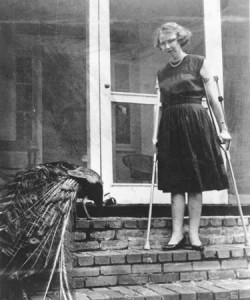 Peacocks were once the kings of the barnyard at the O’Connor farm in Milledgeville, Georgia. They overran the place to such a degree that when editor Robert Giroux paid his author a visit, he recalled being picked up at the front gate and driving up to the house: “The car was going about five miles an hour up this road. As we drove in she had about thirty peacocks strutting around. They’re very beautiful, but very stupid, and their trains were trailing. They were so slow that the car would run over the trains.”
Peacocks were once the kings of the barnyard at the O’Connor farm in Milledgeville, Georgia. They overran the place to such a degree that when editor Robert Giroux paid his author a visit, he recalled being picked up at the front gate and driving up to the house: “The car was going about five miles an hour up this road. As we drove in she had about thirty peacocks strutting around. They’re very beautiful, but very stupid, and their trains were trailing. They were so slow that the car would run over the trains.”
Flannery had long been fascinated by birds, starting when, as a six-year-old, she taught a chicken to walk backward. Peacocks, “with tails that resembled maps of the solar system” (as described by Brad Gooch in Flannery: A Life), eventually became her obsession. In 1952, shortly after being diagnosed with the lupus that would kill her 12 years later, she ordered her first pair of peafowl. With their frightening, rusty shrieks and dazzling display of tailfeathers, the peacocks came to symbolize the terrifying mysteries contained in her stories. In one, she describes a character as having “eyes as blue as a peacock’s neck.”
The birds, then, are the closest we can come to touching Flannery. If you’re into obsessing about the talismans of writers, that is.
The birds currently strutting around Andalusia are not descendants of the original flock. After Flannery’s death and the subsequent slow decay of the farm, those birds were scattered around Georgia: pairs went to live at Stone Mountain, a cancer center in Atlanta and at a monastery in Conyers. About a year-and-a-half ago, the Andalusia Foundation decided to repopulate the farm with peacocks, hoping it would give visitors a taste of what it was like during the Flannery era.
There were no rusty-doorhinge screeches from the trees when I pilgrimaged to Andalusia. But I didn’t need the birds to give me the shivers–I already had that enduring chill from my two-decade obsession with Flannery and her fiction.
This, then, is what it’s like living at the outer limits of obsession. For those of you un-baptized in the spirit of fanaticism, you should know it is possible to absorb so much of a writer’s life and work that you start adopting an unnatural familiarity with someone who died when you were still in diapers–life-size posters on your wall, calling her “Flan” in your most intimate moments, drunk-dialing random numbers and yelling “The life you save may be your own,” that sort of thing. With apologies to my wife, there was indeed a time in my life when I was googly-eyed for Flannery. That particular fever has since passed, but I still regard her works as pillars which hold up the roof of my own fiction.
But back to Andalusia. You know how some folks plan a lifetime for a trip to Paris or Bali-Bali? That was me with the O’Connor farm. When the Army sent me to Fort Stewart, Georgia in 2004, I finally found my chance. I was too busy with pre-deployment training and the subsequent year in Baghdad to make my way to Milledgeville, but once I got back and shook off the Iraqi dust, I started making my plans
* * *
Our car, softly bouncing along the rutted dirt road, topped a small rise, passed through the wooden-gated opening and there, off to the right, was the white house tucked among the tall shade trees, the wide, screened-in porch beckoning like a cupped hand waving us forward.
Andalusia. I rolled the name on my tongue like I was saying “Manderley” or “Rowan Oak.”
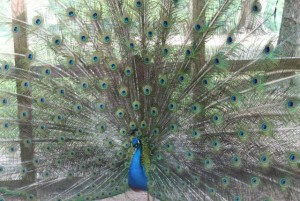 That morning, my wife and I had set the alarm (rusty shrieks!) at a Godawful ungodly hour, got in the car and drove the three hours to Milledgeville. I’d planned out the route on Mapquest, but chose the “shortest route” (rather than the “fastest route”) option so that we could save on 50 miles worth of gas. This turned out to be a nearly disastrous mistake because, after we got off I-16 and then another couple of state highways, we found ourselves going down a deserted one-lane dirt road. The red-clay track led through thick, insect-buzzing woods and there was not another car, house or even telephone wire in sight. We crept down the road at 40 miles per hour for about ten miles, our car pluming a red cloud of dust, and both of us getting increasingly nervous by the minute, thinking that Mapquest was leading us to our doom. We saw a burnt-out carcass of machinery off in the ditch to the right and cracked a joke about how the hillbillies preyed on unsuspecting travelers who depended on the internet for everything. I sang the banjo-twang song from “Deliverance.” At two separate times, sleek, tan does bounded across the road in front of us. My wife fretted about how we should call our daughter and have her retrieve the downloaded Mapquest route from my computer. “That way, if we don’t return, she’ll know where to look for the bodies.”
That morning, my wife and I had set the alarm (rusty shrieks!) at a Godawful ungodly hour, got in the car and drove the three hours to Milledgeville. I’d planned out the route on Mapquest, but chose the “shortest route” (rather than the “fastest route”) option so that we could save on 50 miles worth of gas. This turned out to be a nearly disastrous mistake because, after we got off I-16 and then another couple of state highways, we found ourselves going down a deserted one-lane dirt road. The red-clay track led through thick, insect-buzzing woods and there was not another car, house or even telephone wire in sight. We crept down the road at 40 miles per hour for about ten miles, our car pluming a red cloud of dust, and both of us getting increasingly nervous by the minute, thinking that Mapquest was leading us to our doom. We saw a burnt-out carcass of machinery off in the ditch to the right and cracked a joke about how the hillbillies preyed on unsuspecting travelers who depended on the internet for everything. I sang the banjo-twang song from “Deliverance.” At two separate times, sleek, tan does bounded across the road in front of us. My wife fretted about how we should call our daughter and have her retrieve the downloaded Mapquest route from my computer. “That way, if we don’t return, she’ll know where to look for the bodies.”
“Wait,” I said. “What’s that up there? Is that a Stop sign?”
It was, indeed. And there was a paved highway, cleanly bisecting our dirt road of doom. Mapquest told us to take a left and soon we were back in civilization once more.
Sort of.
We needed to stop for gas and pulled into the first station we found—a dusty yard with three pumps on an island in front of the squat little mini-mart whose windows were crowded with lottery stickers and Salem cigarette ads. I told my wife I needed to use the restroom while she pumped.
She gave me a Look, which said, in no uncertain terms, “How in the world did I end up with a man so full of shit?”
When I entered the store and made my way past the racks of bagged peanuts, sausage sticks and Moon Pies, I was confronted with a line of Locals, all of them in their sixties or seventies and all of them wearing John Deere caps and not-recently-laundered T-shirts. They perched on stools along a short counter in front of a grill where a cook was scrambling up eggs and burgers. The Locals eyed me—me, in my ironed shirt and city-slicker shorts and tennis shoes—and there was a barely-perceptible pause in their conversation. The grill sizzled in the half-beat silence. One of the good ole boys nodded at me and said, “How you?”
“Fine,” I said. “Fine, thanks.”
I hurried into the bathroom, did my business (“bid’ness”) then hurried back out to protect my wife while she pumped and paid and we sped away after buying a bag of salted cashews and a Diet Coke. She wanted to buy a plastic baggie of boiled (“bolled”) peanuts that were sitting at the register, but I talked her out of it, later saying, “We have no idea how long they’ve been sitting there.”
We had a good (nervous) laugh about the gauntlet of Locals back at the gas stations.
“Yep,” I said, “we’re definitely in Flannery Country now. Them there was Good Country People.”
We arrived at Milledgeville, browsed the antique shops, ate lunch, then I said, “Okay, it’s time.” My voice quivered as I spoke. We headed north out of town on Highway 441 and there, sandwiched between a Honda dealer and a row of motels, was the driveway with a small brown sign pointing the way to Andalusia. I drove slowly down the dirt road, topped the rise, and had my first glimpse of the white country house where Flannery wrote Wise Blood, The Violent Bear it Away and nearly all of her short stories. We drove around behind the house and parked in the grassy field.
The afternoon air was thick and hot, too hot for even a decent insect buzz. We walked up the steps to the screened-in porch and I stepped inside the Main House. Craig Amason, the Foundation Director, was there to meet us. He told me everything I already knew, and I nodded politely with feigned interest. I was now at the professional-level of tuning out tour guides.
Mr. Amason paused in his spiel about the long-gone peacocks. “Just out of curiosity, how’d you hear about Andalusia?”
I looked at him and grinned. “Mister, I’ve been waiting to get here for fifteen years. You have no idea.”
At that point, a trio of loud-mouthed ladies swept onto the property and bullied their way through the front door. It was as if Mrs. May, Julian’s mother, and the Grandmother in “A Good Man is Hard to Find” had conspired to gang up on my pilgrimage to the Shrine.
My wife and I slipped away to explore the rest of the house on our own.
Most of the farmhouse was roped off—the front staircase leading to the second floor, the parlor, Flannery’s bedroom directly to the left of the front door—but I stood in each of the doorways for many long minutes, absorbing the ghost of Flannery. Deep down, I knew this would not make me a better writer. Being here would not fortify my fiction with eight essential vitamins and minerals. But yet, there was something about standing witness to her environment where she practiced “the habit of being” even as disease weakened her body. She once wrote: “I have enough energy to write with and as that is all I have any business doing anyhow, I can with one eye squinted take it all as a blessing.” If she could do it, so could I.
Somewhere, beyond the flapping gums of the ladies behind us, I could hear the click of her crutches as she advanced to meet me. I stared at her desk (“Not the original, unfortunately,” the director said) and the typewriter (“Again, not the original, but one just like it”) that were positioned to the left of the bed (the original) and in front of the window. Flannery would sit there every morning, the morning light streaming through at her back, and peck away at the typewriter, rattling out her message of faith and violence and goddamngreat prose, sending a message to me forty years in the future. I asked the director if the books in the glass bookcases were hers, and he affirmed that they were (“Though the bulk of her private library and papers are at the college, of course”). The velvet rope kept me from entering the room, forced me to cock my head and read the spines of the books, but just knowing they were hers frissoned me head to toe. I stared at her silver crutches leaning against the un-original desk. I stared at the curtains her mother Regina had sewn. I looked at the cracks running along the wall, meeting the ceiling, then spreading out in spidery veins. I thought about water stains in the shape of the Holy Ghost descending along the wall.
My wife bought me a T-shirt and we left the house, the three biddies still clucking at the director, trapping him into false good manners and a strained smile.
We walked around the grounds, me stopping to pose on the porch and in front of the house, my wife worrying about snakes as she stepped in her sandals through the crackly undergrowth near the stone birdbaths, both of us poking our heads into the ruins of the caretakers’ house, the equipment shed, the cow barn and the milk shed. Then we left, just barely escaping ahead of the three ladies in their large SUV.
I turned to my wife, “Now I can die. I’ve been to my Mecca.” I paused. “There’s just one thing…”
“What?”
“We’ve got a long drive home ahead of us. I probably should have used the bathroom before we left Andalusia.”
*I am resisting the obvious play on words here.
**There are, to the best of my knowledge, no such rules. It’s just one of the things I may have exaggerated in this account (others being: the glare-white strength of the legs belonging to the tourist who may or may not be from Florida, the baldness of the docent, and the way I have undoubtedly scrambled and rearranged the layout of the house). I make no apologies for the few instances of fiction I may have injected at opportune moments. When it comes to stories like this, I adhere closely to what O’Connor herself once said: “to the hard of hearing you shout, and for the almost-blind, you draw large and startling figures.”
 David Abrams’ debut novel about the Iraq War, Fobbit, was named a New York Times Notable Book of 2012 and a Best Book of 2012 by Paste Magazine, St. Louis Post-Dispatch and Barnes and Noble. It was also featured as part of B&N’s Discover Great New Writers program. One of his short stories, “Roll Call,” was included in the anthology Fire and Forget (Da Capo Press, 2013). His short stories have been nominated for the Pushcart Prize and have appeared in Esquire, Narrative, Electric Literature, Consequence, Salamander, The Literarian, Connecticut Review, The Greensboro Review, Five Chapters, The Missouri Review, and many other places. His work has also appeared in the New York Times and Salon. He regularly blogs about the literary life at The Quivering Pen
David Abrams’ debut novel about the Iraq War, Fobbit, was named a New York Times Notable Book of 2012 and a Best Book of 2012 by Paste Magazine, St. Louis Post-Dispatch and Barnes and Noble. It was also featured as part of B&N’s Discover Great New Writers program. One of his short stories, “Roll Call,” was included in the anthology Fire and Forget (Da Capo Press, 2013). His short stories have been nominated for the Pushcart Prize and have appeared in Esquire, Narrative, Electric Literature, Consequence, Salamander, The Literarian, Connecticut Review, The Greensboro Review, Five Chapters, The Missouri Review, and many other places. His work has also appeared in the New York Times and Salon. He regularly blogs about the literary life at The Quivering Pen
[Love this post as much as we do? Don’t forget to LIKE it, and like Bill and Dave’s by hitting the button upper right.]
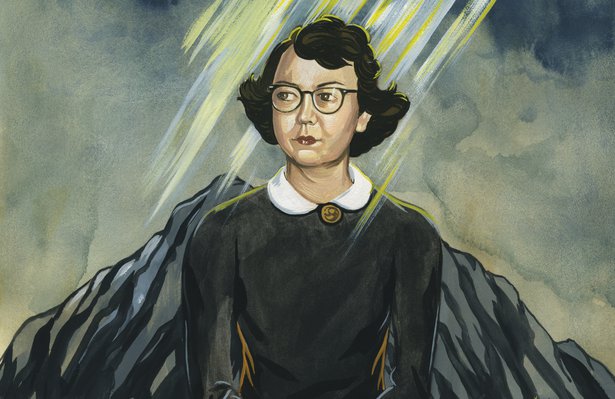
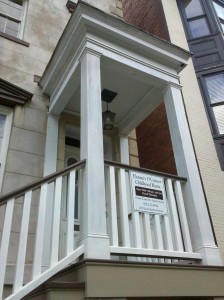

THE PERSON(ALITY) OF FLANNERY O’CONNOR
Ms O’Connor was a classic authoritarian personality. This is not unusual. What is unusual is that she
successfully fended off Inquiries that might lead to an examination of this. It is also unusual that
almost every dimension, element, perspective of her violent stories and their authorial source has
been examined…AND rationalized… but not her personality.
Cleverly, she erected a wall around her own personality…and gave very few access… by early denying
that psychology had much to do with anything. Her life was tragic. But her devotees…now a cottage
industry…have been relentless in glossing her work and image. For the most part they neither examine
her nor her religious claims…in any depth. These were what was important about Flannery O’Connor.
Her persona was that of a Catholic theologian and severe apologist…with violent twists. Thus,
evangelicals rush past these troublesome considerations. The superficial path is most often taken
as in these considerations.
Especially interesting is her pronouncement of orthodoxy regarding her creations as though the
Church… with rigorous examination… allowed her to place an imprimatur on her own work.
She was snarky as a little girl of nine and she grew into a snarky defensive adult who rarely deigned
to “suffer fools gladly”. But so what? So what if she did not receive others openly and joyfully?
So what if she created no characters at all with loving, open and optimistic outlooks? Neither
Ms O’Connor nor her characters reflected love of any kind, leastwise the love of God. This should
not surprise!
The question is why is Ms O’Connor given a ‘cultural’ pass on so much that is relevant while piling
analysis and commentary on top of analysis and commentary of her stories that express her self-justifying
therapy and her violent view of God’s will while rationalizing her dark 13th century Thomistic views into
some sort of ‘gospel’ homilies? This should not surprise!
To explain her life and work in any terms of exceptional righteousness or superior cultural perspectives
of her environment, borders on being the theater of the absurd.
Lupus is the key. This too, should not surprise….’the wolf within’ that might begin tearing things apart
at any moment. One cannot begin to imagine living with an illness wherein episodic attacks of one’s
own tissues can arise at any moment to attack one’s own tissues. One wants to shout: it is the ‘wolf”,
stupid! Now sit down and shut up. Stop glorifying and deifying her suffering and making it fit one’s own
slightly askance or twisted comfort zones!
One might conclude that Ms O’Connor’s intellectual/emotional frame of reference was her Roman Catholicism.
Her biological frame of reference was her illness, lupus erthyematosus. Both…and their interplay… created
much tension and stress in her life not to mention the extreme pain. She vented these stresses in her writing.
Her life was so restricted and limited, she dared share with only a few.
One also has to suspect that her dogmatic religious assertions were under-girded with some doubts. She in
fact did some ‘cherry-picking’ of religious concepts while throwing some observers off balance with those
proclamations of Roman Catholic orthodoxy.
Still questions remain. The purpose of this segment is to raise those questions. Why is she not seen as a
desperately lonely and awkward young woman delivering “God’s hammer” to an ‘unhearing’ and unyielding
world of fundamentalist ignoramuses and uncaring secularists? Is this not evident? If not, read more…not
here, elsewhere!
She was viewed as strictly devout, brilliant as a writer, moderately troubled by an obscure illness, a bit quirky.
But was she really seen? Really known? Is it time? Only one asserted she was on the “side of Devil,” John Hawkes.
Did she throw an ink well at ole “Beelzebulb” as did Martin Luther? We shall never know. Sad that she is
misunderstood…seen essentially as a button-down Catholic whose work must be plumbed and plumbed
again for profound spiritual insights… from material that more likely were her exercises to purge her own
soul from the daemons lurking so close. Only Lupus need be considered! Her life was one of violence.
It was redeemed by violence…the attempts to work through it… NOT those oohing and aahing over it.
Loved this piece! Reminded me of a similar encounter I had with my idol Jack London at Jack London House in California Wine Country thirty years ago. Your earthy humor is a joy as always, and I will go back to some of O’Connor’s stories to refresh my mind.
Loved this! Very funny!
Every once in a great while I pull out this book I have, Conversations with Flannery O’Connor. She is so clever and quick always–as in the way of the last line of your essay. Complete confidence, that one. I really really like her.